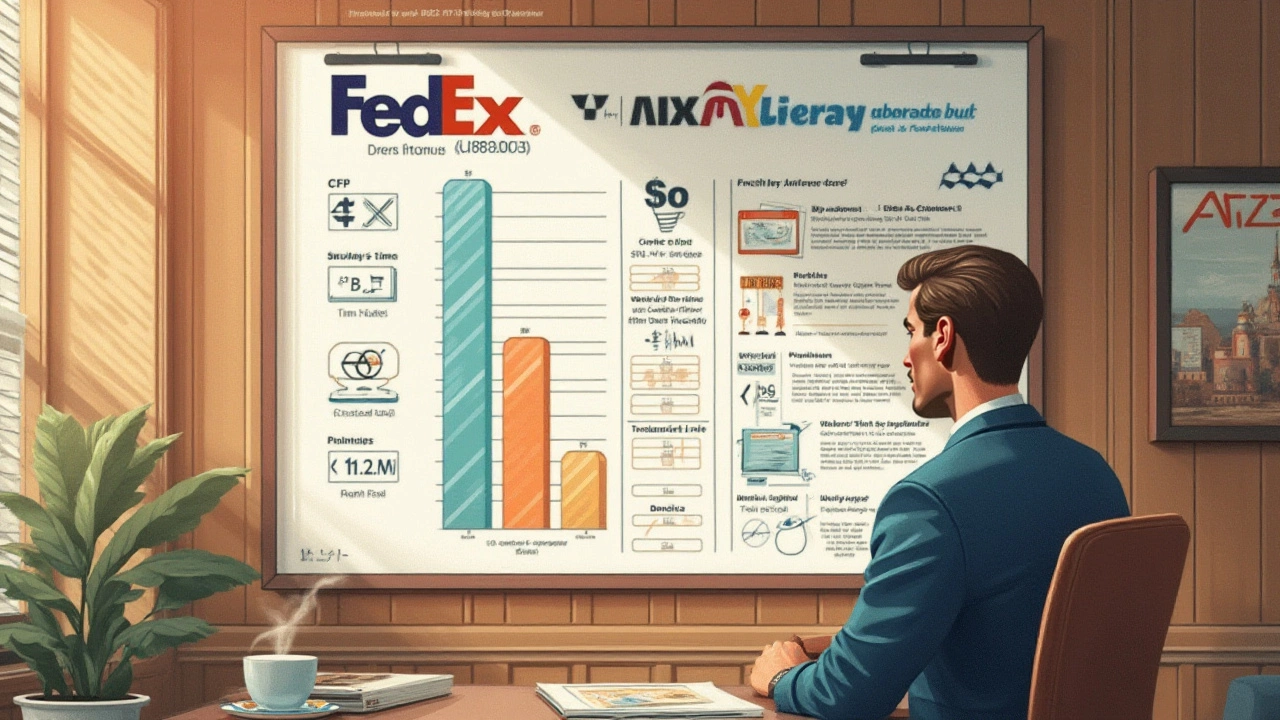Diving into the world of international shipping can be akin to navigating a labyrinth. Two names often stand out—FedEx and UPS. Both are leading giants in the courier industry, renowned for their global delivery networks. Yet, when it comes to cost-efficiency, choosing between FedEx and UPS can be a head-scratcher for many.
In this article, we peek behind the brand veil, exploring aspects beyond just base rates. There's a lot to uncover—from the different services each offers to the occasional unexpected fees that can turn your shipping budget upside down. Understanding delivery times, reliability, and how each company handles international shipments is crucial.
Join us as we dissect these two shipping powerhouses, providing insight that can save not only your pennies but also your peace of mind when your package is making its way across the globe.
- Understanding FedEx and UPS Services
- Comparing Cost Structures
- Delivery Times and Efficiency
- Customer Experiences and Satisfaction
- Hidden Fees and Considerations
- Tips for Choosing the Right Carrier
Understanding FedEx and UPS Services
When considering international shipping, both FedEx and UPS present a broad range of services that cater to different needs and requirements. FedEx, famously known for revolutionizing the overnight delivery market, offers a plethora of shipping services that span across the globe. From document express services to hefty freight shipments, FedEx prides itself on efficiency and speed. Their flagship service, FedEx International Priority, ensures time-definite delivery typically within 1-3 business days, covering more than 220 countries. On the other hand, FedEx International Economy offers a less expensive alternative with a slightly longer delivery span. They also provide specialized solutions like temperature-controlled shipping for sensitive cargo, which is crucial for industries like healthcare and food.
UPS, on the opposite side of the delivery world, stands as a reliable courier service with its roots deeply entrenched in the logistics sector. Known for its brown delivery trucks and extensive global network, UPS offers a variety of cost-effective options. Their UPS Worldwide Express guarantees early morning deliveries, while UPS Worldwide Saver serves those who need their parcels by the end of the business day. UPS Worldwide Expedited is a strong competitor to FedEx’s Economy service, typically offering delivery within 2-5 business days, providing an excellent balance between speed and cost. A noteworthy mention is their commitment to sustainability, with a massive investment in green technologies that reduce carbon emissions.
"In recent years, both carriers have enhanced their digital tools, offering shipment tracking and advanced analytics. This shift has helped businesses just like ours," said a logistics expert in a recent interview with Supply Chain Magazine.
These services certainly come with options to upgrade or ensure additional security, giving individuals and businesses alike flexible solutions to choose from. Both carriers also provide extensive customer support through digital platforms, facilitating smoother communication and quick problem resolution. Importantly, FedEx boasts a strong suite of technology-enhanced features, including customizable reporting for businesses and visual tracking. Meanwhile, UPS harnesses its broad supply chain expertise, offering logistics solutions that streamline the shipping processes and align with business growth strategies. Exploring these services in-depth reveals a kaleidoscope of possibilities when shipping internationally, making it crucial to understand each carrier's unique offerings to make the best decision for your specific needs.
Comparing Cost Structures
When we start analyzing cost structures between FedEx and UPS, many factors surface, impacting the ultimate cost you pay for delivering a package overseas. These two logistics giants offer robust service plans, but diving deeper reveals differences in how they price their services. FedEx often markets its International Priority and Economy services, each catering to different needs. In contrast, UPS introduces its Worldwide Express and Saver services, which appear similar yet have varied pricing dynamics.
To begin with, consider the base pricing. FedEx International Priority might have a higher base rate compared to UPS Worldwide Express. However, the distinction becomes apparent when you add variables such as package weight, dimensions, and destination zones. UPS tends to provide slightly more competitive rates for heavier shipments over longer distances, while FedEx’s tiered pricing model might offer slight advantages for lighter packages. These subtleties can make a world of difference, particularly for small businesses needing frequent international logistics solutions.
Another critical factor is the surcharges that accompany the base rates. This can include fuel surcharges, which are adjusted monthly and affect both companies, but not equally. Often, UPS may have a more modest surcharge depending on global fuel price fluctuation, making them a potentially less expensive option during periods of rising fuel costs. Additional fees like residential delivery surcharges, brokerage fees for customs, and Saturday delivery premiums also differ, sometimes unpredictably. These costs are where both your budgeting and strategic planning become crucial.
Discounts and Volume Pricing
An oft-overlooked aspect is the volume discounting both companies offer. Regular shippers—or those sending goods in bulk—might be able to negotiate more favorable terms with FedEx or UPS. Businesses that frequently export products overseas often choose a primary carrier based on these discounts. FedEx might provide steeper discounts on International Economy options for businesses shipping to certain countries frequently. Alternatively, UPS’s comprehensive supply chain services might offer convenience benefits coupled with cost savings.
A report from International Shipping Review once noted, "While both FedEx and UPS entice customers with competitive rates, FedEx surprisingly edges out on long-term loyalty discounts in specific regions."Hence, evaluating the long-term relationship potential with either firm could lead to significant savings down the road.
Evaluating these components helps in deciding which service suits your objectives. A speculative choice could lead to unexpected expenses, but informed decisions turn this complexity into clarity. Importantly, reviewing rates and asking for tailored quotes based on your shipping profile may yield surprising deviations from standard pricing, often to the shipper's advantage.

Delivery Times and Efficiency
When it comes to international shipping, the speed and efficiency of delivery can make a world of difference. For those clock-watching for crucial parcels from one corner of the globe to the other, FedEx and UPS offer competitive delivery timelines. FedEx Express is known for its swift delivery options, providing services like International First that deliver in just one to three business days. This service targets major destinations worldwide and promises early morning deliveries. UPS, on the other hand, boasts their UPS Express Critical service, which can also provide urgent deliveries on a similar timeframe. However, is one really faster than the other? It often depends on the specific locations involved and the customs processing times.
Both carriers excel at providing efficient tracking systems, ensuring that packages can be traced from pickup to delivery. This transparency helps customers gauge when to expect their deliveries better. UPS claims to have industry-leading reliability metrics. Meanwhile, FedEx's powerful distribution network, bolstered by a fleet of over 600 aircraft, is a formidable force in maintaining time-definite deliveries across continents.
Interestingly, reliability doesn't always align perfectly with speed. Anecdotes of local customs clearances, weather-related delays, and remote destination challenges often pepper the experience of customers with both companies. It's essential that businesses weigh the trade-off between speed and potential hurdles that could impact delivery times. Those extra twelve hours in transit might make no difference or all the difference, depending on the urgency of the shipment. Large-scale logistics enterprises frequently report mixed experiences, with some swearing by one company for a particular route or region due to consistent performance over time.
"Speed is good but dependability is key for us," David Abney, a former UPS executive, once remarked, emphasizing the balancing act companies strive to maintain between brevity and trustworthiness.
Should one consider efficiency in terms of specialist services offered by both carriers? UPS and FedEx both provide temperature-controlled logistics services, crucial for pharmaceuticals or perishables. However, the choice might hinge on the specific infrastructures each company has in place for such critical services along given routes.
It's important to mention that delivery times can be heavily influenced by factors such as package size, weight, destination, and even the sender's origin. Services with top-tier speed are often not the most cost-effective, especially for heavy or large shipments, where freight might offer more feasible solutions. Hence, understanding one's shipping needs thoroughly can prevent surprises at checkout when urgency leads to unexpected expenditure.
Customer Experiences and Satisfaction
When deciding between FedEx and UPS for international shipping, the customer experience is often a significant determining factor. Both companies are seasoned veterans in the logistical realm, yet subtle nuances in service can lead to marked differences in customer satisfaction. Individuals and businesses that frequently deal with international parcels have spilled ink addressing what they love and what might irk them about each service. FedEx often garners praise for its well-organized tracking system. Customers value transparency during transit, especially for international deliveries that dance to their own tune. The consistent updates through email and mobile notifications help assuage the anxieties of shipping amidst geopolitical and logistical challenges.
On the flip side, UPS doesn't shy away from ensuring customer satisfaction either. It is famous for its reliable network, which many users remark as unmatched, even in remote or challenging destinations. Its policy of proactive customer support is a cherished feature among clients used to confronting hiccups in international logistics. People often speak highly of their prompt and solution-focused responses, which can make a world of difference when goods encounter delays or inconveniences. That said, there are forums and community discussions hinting that UPS might fall short when it comes to initial expectations set by their time estimates, specifically in peak times when shipments can hit speed bumps.
Of course, not all experiences are cut from the same cloth. A survey of customer reviews reveals that both carriers sometimes face criticisms on issues such as delivery damages or misplaced packages. It is important to note, however, that these are usually outliers and can come down to specific route or operational day nuances. Customer feedback also underscores the importance of local factors—while one may perform spectacularly in the United States, logistical agility may falter in another nation due to third-party dependencies. An interesting insight from a logistics annual review indicated that FedEx tends to rank higher in customer trust when shipping fragile items. It might be owing to their premium packaging options or possibly a cultural ethos on handling delicate parcels.
According to a report in The Wall Street Journal, "FedEx’s intricately detailed feedback loop with consumers has provided them a slight edge when building trust across diverse demographics.”
It's fascinating, then, to delve into the psyche of brand loyalty. Some customers choose FedEx solely because of their superior handling of unexpected snag points in countries with volatile import-export regulations. Others might prefer UPS for its exemplary record in overhauling delivery forecasts during unpredictable weather conditions. Ultimately, when choosing between FedEx and UPS, it's wise to carefully consider personal priorities, whether that's tracking transparency, network reliability, or customer service responsiveness. Every shipment tells a story, and depending on your needs, these couriers will write it differently.

Hidden Fees and Considerations
When venturing into international shipping, the initial rates advertised by carriers like FedEx and UPS might not paint the full picture of what you’ll end up paying. Both companies have a multitude of fees that can sneak up on you if you're not careful. These additional charges often stem from factors such as package dimensions, weight, and the specific destination. It’s essential to realize that the base rate is merely the starting point for calculating the total cost of shipping. For instance, a seemingly small package could incur oversized package surcharges if its dimensions exceed a certain limit, with both FedEx and UPS having slightly varying thresholds.
Another aspect to consider is the fuel surcharge, which can fluctuate based on global fuel prices and index adjustments. Fuel surcharges can substantially alter shipping costs, but they're also an industry-standard due to the nature of long-distance transport services. You’ll find this disclosed separately when you receive your invoice, and understanding how this is calculated can offer you better foresight in budgeting your expenses. Moreover, a savvy shipper should be aware of fees like customs brokerage charges. Since international shipments cross borders, clearing customs can involve extra delays and costs. To expedite customs clearance, both FedEx and UPS offer brokerage services. These, however, are not without fees, and it’s prudent to evaluate if third-party brokerage might reduce your costs.
“Price transparency is key in international shipping businesses. Both FedEx and UPS provide detailed information on additional charges, yet shippers often overlook the small print,” says Claire Daniels, a logistics consultant at FreightVet. “Take an hour to read through potential surcharges on both their websites. It empowers you with the knowledge to avoid unexpected expenses.”
Peak Season Surcharges
If your shipping needs coincide with peak seasons, be prepared for additional costs. FedEx and UPS both implement peak surcharges to offset the additional handling challenges during times of heightened demand, such as around the holidays. This surcharge affects oversized packages predominantly, as well as those requiring special handling, and can significantly inflate your shipping budget. Be strategic about your shipping schedule to minimize these costs wherever possible.
In the realm of international shipping, insurance costs also need to be factored into your considerations. Both FedEx and UPS offer declared value coverage options which function akin to insurance in case of damage or disappearance of goods. However, discerning the coverage limitations and the potential extra cost is crucial. While the first $100 of value is often covered by default, declaring higher values attracts additional fees. Therefore, businesses that send high-value items globally need to judiciously choose coverage levels to balance risk and cost. Delving into the labyrinth of fine printing can offer a plethora of cost-saving and efficiency-improving opportunities.
Tips for Choosing the Right Carrier
In the vast and sometimes overwhelming landscape of international shipping, selecting the right carrier is akin to picking the perfect travel partner for a long journey. With heavyweights like FedEx and UPS offering a plethora of services, making an informed choice requires considering an array of factors tailored to your specific needs. If cost is your primary concern, it’s vital to dive deep into the cost structures of both these companies. Factors such as dimensional weight pricing, fuel surcharges, and potential customs fees can suddenly make a seemingly affordable option less so. One piece of advice often recommended by logistics professionals is to obtain a detailed quote for your shipment.
Reliability is another cornerstone in choosing the right carrier. FedEx and UPS both boast impressive networks and swift delivery promises, yet it's crucial to examine delivery statistics and customer reviews. Interestingly, a study showed that customer satisfaction often ties closely to how well each carrier handles exceptions, like customs delays or weather-related setbacks. Take time to look into each company's package tracking capabilities, as having immediate updates on your shipment's location can alleviate much of the anxiety associated with international shipping. Don't overlook the importance of ease of use, particularly when it comes to the carrier’s online platforms, which can save you time and headaches.
Let’s talk about customer support. Whether you're a business with high volume shipping needs or an individual sending a gift overseas, responsive customer service can make a significant difference. Both FedEx and UPS offer comprehensive customer service, but it pays to read reviews or ask others about their personal experiences, especially if your package is on a crucial timeline. Anecdotal evidence suggests that FedEx sometimes offers more personalized interactions due to its focus on business solutions. Moreover, thinking about scalability—I mean, today you might ship one package, but tomorrow it could be one hundred—definitely matters. Your preferred carrier should be able to adjust to your evolving demands.
Finally, consider any value-added services that might benefit you, such as package consolidation, advanced tracking tools, or climate-sensitive packaging for delicate goods. Both FedEx and UPS have various loyalty programs and discounts especially for businesses shipping in bulk. Checking these out can uncover hidden opportunities for saving. A former VP of logistics once said, "Choosing the right carrier doesn't end with the click of a mouse; it's about nurturing a partnership that understands your priorities." This underscores the importance of building long-term relationships with your chosen carrier to optimize shipping efficiency and cost-effectiveness over time.
FedEx and UPS each have unique strengths. Ultimately, it's a personal decision, and there’s no universal right answer, but being informed equips you to choose confidently. Remember to reassess your choice periodically as both carriers and your own needs continue to evolve.


